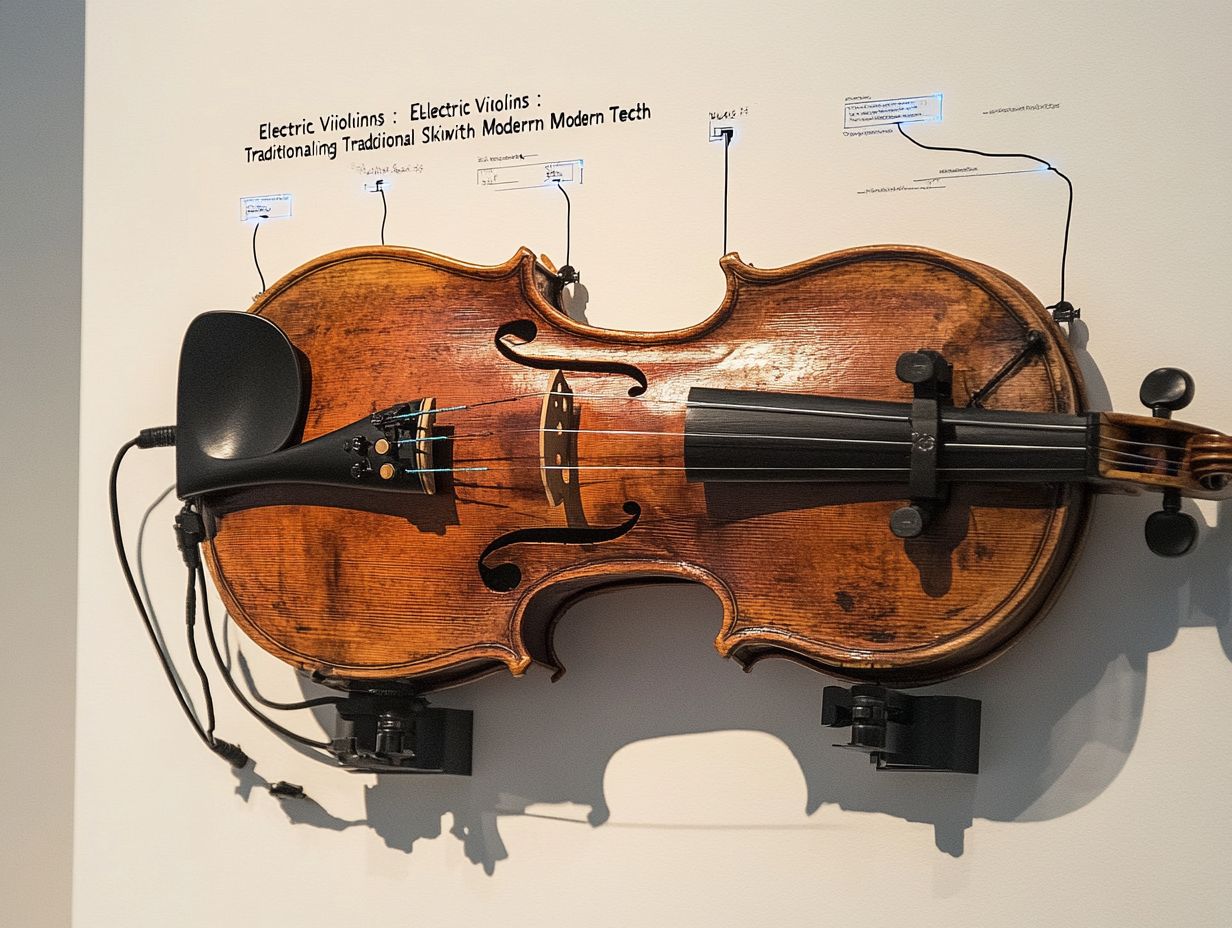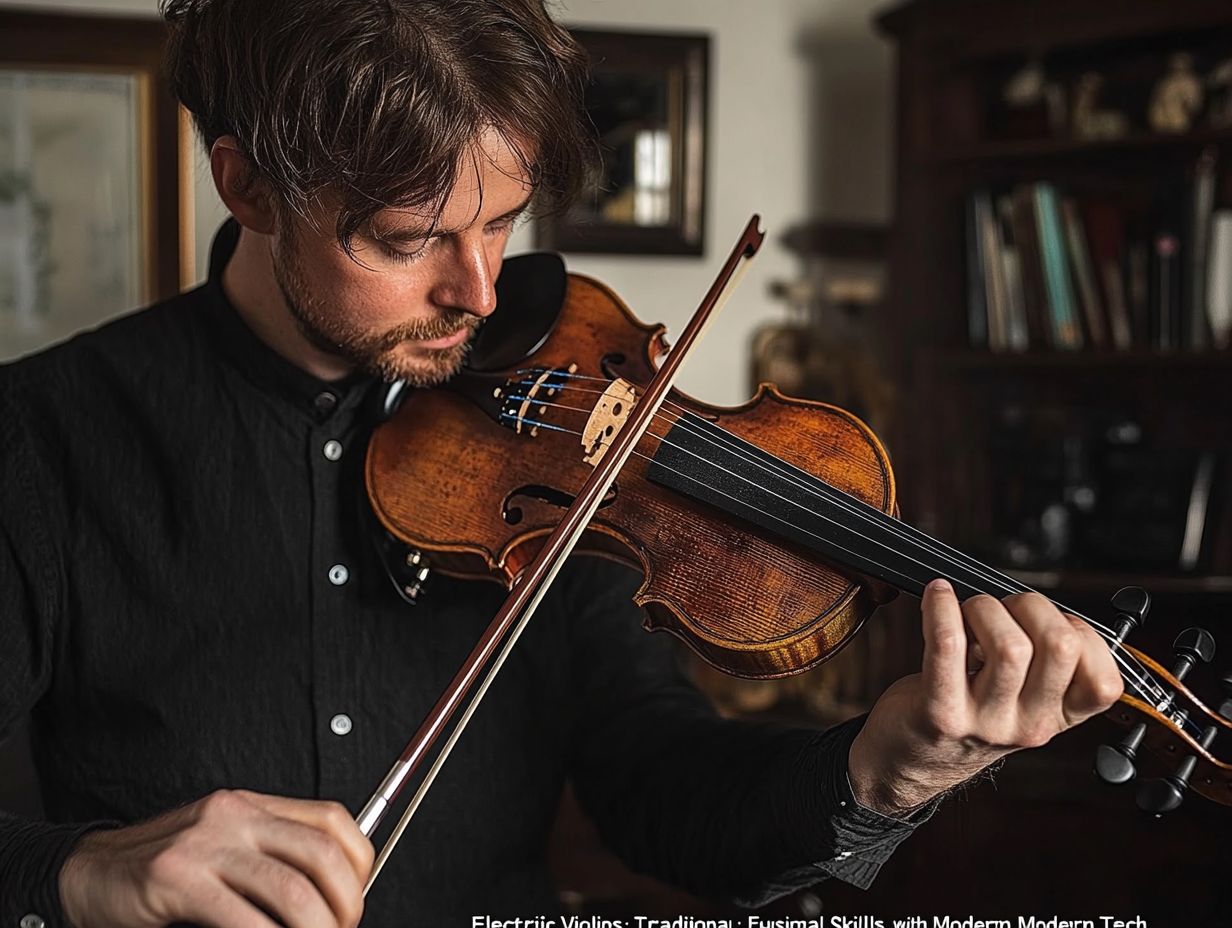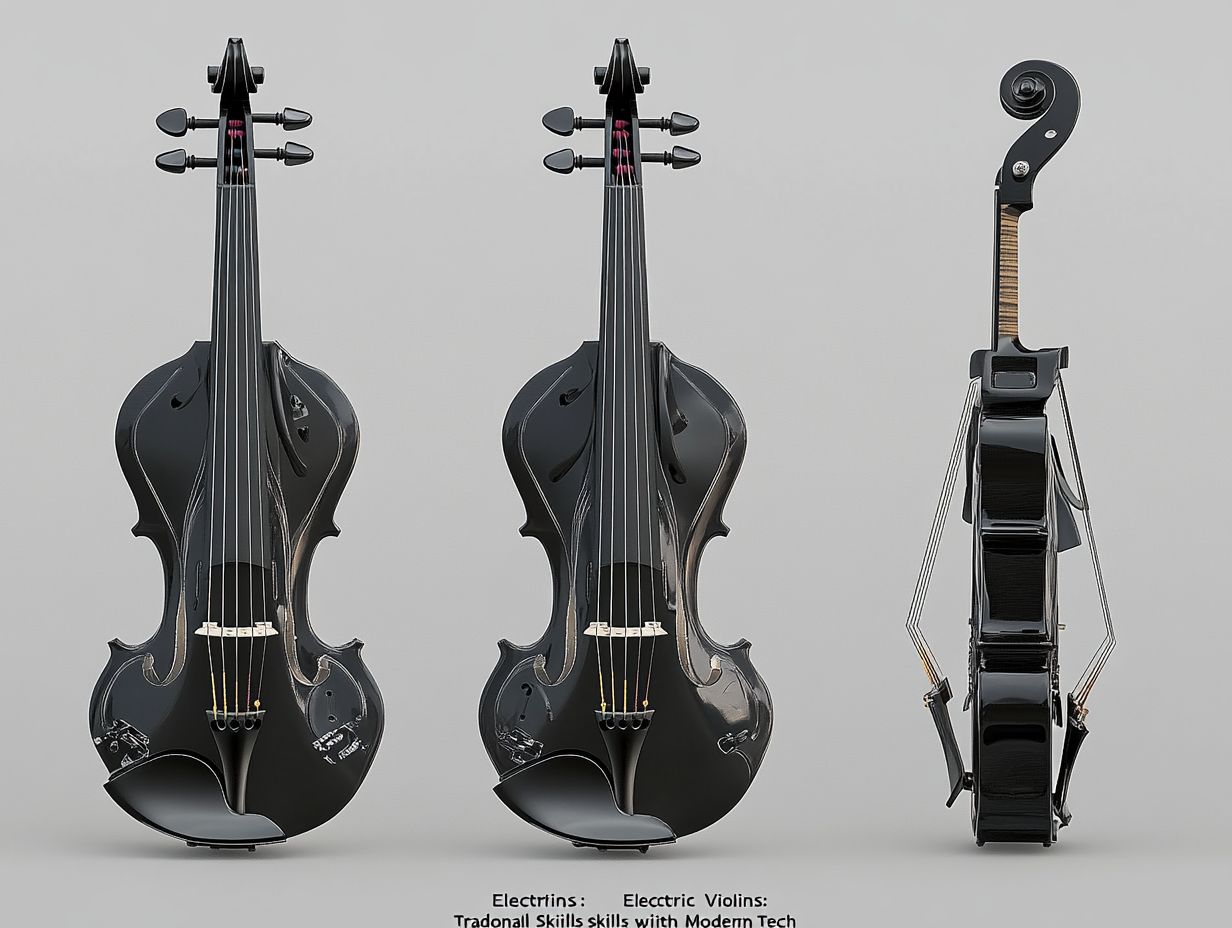Electric violins are transforming the way musicians engage with this timeless instrument by merging classical artistry with modern technology.
From their historical development to the latest innovations, electric violins provide unique advantages in sound quality and versatility. Gaining an understanding of how these instruments function, making the transition from traditional violins, and exploring leading brands will help players make informed decisions.
Additionally, proper maintenance tips will ensure that your electric violin remains in optimal condition. Explore the world of electric violins and discover the enhanced possibilities they can offer for your musical journey.
Contents
What are Electric Violins?

Electric violins are innovative string instruments that merge traditional craftsmanship with modern technology, providing musicians with a unique way to engage with their art. These instruments employ advanced electronics and amplification systems to enhance sound quality, allowing for improved tuning, dynamics, and resonance during live performances or recordings.
Along with their impressive audio capabilities, electric violins are noted for their lightweight design and portability, making them an ideal choice for musicians across various genres and performance settings.
The creative potential of electric violins goes beyond that of their acoustic counterparts, featuring a range of styles from sleek, contemporary designs to visually striking models influenced by rich cultural traditions. Musicians can customize these instruments with various pickups and effects, giving them the ability to modulate sound with precision through intuitive user interfaces, which enhances their performance flexibility.
Unlike traditional violins, which depend solely on acoustic resonance to project sound, electric violins allow for the manipulation of tone and volume, enabling players to explore a wide array of sounds. This versatility not only attracts classical performers but also appeals to artists from pop, rock, and even experimental genres, highlighting the electric violin’s ability to adapt and redefine musical expression.
History of Electric Violins
The history of electric violins is a captivating journey that charts the evolution of string instruments from their traditional origins to the innovative designs we see today. Starting in the late 19th century, the introduction of electric amplification revolutionized the way musicians approached performance, enabling greater sound reproduction and improved feedback control.
Over the decades, advancements in materials and craftsmanship techniques have allowed manufacturers to create versatile instruments that cater to a variety of styles and genres, effectively responding to market trends and the needs of contemporary musicians.
Evolution and Innovations
The development of electric violins has ushered in innovations that enhance both their functionality and appeal, merging modern technology with musical artistry. Notable advancements, such as the introduction of MIDI capabilities and advanced audio processing, exemplify the high-tech features that electric violins now incorporate, enabling musicians to experiment with sound in ways that enrich their performances.
These enhancements improve playability and provide electric violinists with a wider range of customization and sound modulation options, reflecting the rapidly evolving nature of the music industry.
Musicians can seamlessly blend diverse genres, using sound experimentation to create unique auditory experiences that push the boundaries of traditional string instruments. The incorporation of digital effects has transformed the sonic landscape of electric violins, allowing players to manipulate tones and textures in real-time.
User feedback plays a crucial role in shaping these technological advancements, as musicians share insights and preferences that lead to further improvements in ergonomics and sound quality. As artists continue to explore new avenues of expression, the electric violin remains at the forefront of this dynamic intersection between technology and creativity.
Benefits of Electric Violins

Electric violins offer a variety of benefits that enhance the playing experience for musicians in various genres. These advantages include:
- Superior sound quality
- Versatility
- Lightweight design
- Portability
- Options for customization
Improved Sound Quality and Versatility
One of the most valuable features of electric violins is their improved sound quality, which enhances sound projection and adaptability for various musical styles and performance techniques. Musicians can effortlessly achieve a broader range of tones and dynamics, enabling them to adapt to a wide variety of genres, from classical to modern music.
This adaptability is supported by the advanced amplification systems of electric violins, as well as their high-quality materials and craftsmanship techniques. The unique acoustic characteristics of the instrument blend with electronic enhancements to facilitate sound modulation, which can be crucial in performance settings.
The resonance produced by different types of wood, composites, and strings plays a significant role in the overall sound quality. For instance, using mahogany instead of maple would alter the instrument’s tone and its interaction with other musical components, resulting in a warmer and richer sound or a brighter and punchier tone, respectively.
This versatility allows performers to explore a wider dynamic range, seamlessly transitioning from very subtle to very loud passages, thus enriching the expressiveness and depth of their performances.
How Electric Violins Work
Electric violins consist of a body, strings, an electronic pickup system, and an amplification unit. The body holds the strings under tension, and when a musician draws the bow or plucks the strings, the resulting vibrations are captured by the violin’s electronic pickup system.
These vibrations are then converted into an electronic signal, which is transmitted through audio interfaces and amplification systems, enabling high-quality sound reproduction. Musicians can alter the sound reproduction to suit their style, allowing electric violins to utilize digital effects for sound experimentation, which provides them with a unique advantage.
Components and Technology

The components of electric violins are meticulously designed to work in harmony, utilizing advanced technology to enhance the overall performance experience. Key elements include pickups that capture the vibrations of the strings, amplifiers that improve sound quality, and electronics that provide MIDI capabilities, enabling musicians to connect their instruments to various digital interfaces.
This integration broadens the possibilities for musicians, allowing for more complex sound modulation and experimentation, which fosters greater artistic expression and versatility in performance settings.
For instance, pickups are crucial in electric violins as they capture the unique tonal characteristics of each string, enabling subtle nuances in playing technique to be expressed. While each component serves its primary function, they also provide opportunities for customization of the instrument. Musicians can tailor their setups to fit their preferences, adjusting settings to achieve the desired soundscape.
Sophisticated amplification systems with multiple equalization processes allow for adjustments that can significantly alter the sound profile, making them essential tools for sound designers as they adapt their performances to different environments.
Learning to Play Electric Violins
Learning to play the electric violin can be a challenging process for aspiring musicians, especially for those who already have experience with traditional violins. While the mechanics of playing are generally similar between acoustic and electric instruments, electric violins come with unique features that introduce a new learning curve.
The most common method of playing an electric violin resembles that of a traditional violin, with bowing and finger movements being nearly identical. However, electric violins often include microphone and amplifier systems, which require players to learn new bowing techniques that are unnecessary for traditional instruments.
For instance, some electric violinists may practice specific bowing techniques to help control the volume of the sound they produce. Additionally, the distinctive qualities of electric violins can be employed in innovative ways, such as controlling effects or triggering external sounds, pushing musicians to explore different playing techniques.
Utilizing appropriately chosen instructional resources and practice tools can greatly assist aspiring musicians in becoming proficient with their electric violins.
Transitioning from Traditional Violins
Transitioning from traditional violins to electric violins presents unique opportunities and challenges for musicians. While many foundational skills, such as bowing techniques and tuning mechanisms, remain applicable, players must adapt to the specific features of electric instruments, including sound modulation and amplification. This transition often requires familiarizing oneself with a new range of sounds, dynamics, and performance settings that electric violins offer, making it an enriching experience for those willing to embrace change.
Incorporating techniques such as effects pedals and sound programming enhances musicians’ ability to create customized tones, opening a world of sonic experimentation. Understanding the nuances of sound design enables players to manipulate their output in ways that traditional violins do not allow, offering richer textures and layers to their performances.
Audience engagement also evolves, as electric violins can be amplified to reach larger crowds or mixed with backing tracks, transforming how musicians connect with listeners. Therefore, mastering these new tools is essential for artists who want to craft an unforgettable experience and showcase their creativity.
Top Brands and Models of Electric Violins

The following are some of the most popular and top electric violin brands and models. Understanding these leading electric violin brands and models is essential for navigating the market.
Electric violin manufacturers offer a variety of models designed to cater to different types of players, from beginners to professionals, ensuring that musicians of all skill levels can find equipment that meets their needs. These models vary in price and come with various features, including customization options, sound reproduction capabilities, and ergonomic designs that enhance playability.
Features and Price Ranges
The features and price ranges of electric violins significantly influence a musician’s choice, impacting both their performance and overall satisfaction. These instruments vary from budget-friendly options suitable for beginners to high-end models designed for professional musicians who seek superior sound quality and advanced features. Key features to consider include sound modulation capabilities, amplification systems, and the materials used in construction, as these factors directly affect the instrument’s playability and artistic expression.
Customers in the lower price bracket typically find models that prioritize ease of use, making them ideal for those just beginning their musical journey. Mid-range selections offer improved sound quality and more durable materials, appealing to amateur musicians who wish to invest in their craft without overspending. In contrast, premium electric violins incorporate advanced technology and exceptional craftsmanship, attracting professionals who demand high performance and a reputable brand.
Consumer trends indicate a growing interest in customizable options, and it is essential to consider maintenance tips to ensure the longevity and continued satisfaction with one’s purchase.
Maintenance and Care for Electric Violins
Proper maintenance and care of electric violins are essential for ensuring their longevity and optimal performance. Although electric violins are designed to be more durable than traditional violins, they still require regular upkeep to maintain their sound quality and functionality.
Key maintenance practices for electric violins include:
- Routine cleaning
- Checking electronic components
- Making repairs or adjustments as needed
Understanding the unique characteristics of electric violins, such as their materials and craftsmanship techniques, can significantly aid in preserving their condition.
Tips for Keeping Your Instrument in Top Shape
To keep an electric violin in optimal condition, it is essential to follow maintenance tips and care practices that safeguard the instrument’s durability and performance.
Regular cleaning is crucial; wiping down the body and strings after each session prevents the buildup of rosin dust and keeps the instrument looking new.
Proper storage is another critical aspect; using a padded case with humidity control helps protect against environmental damage that can affect sound quality.
Additionally, employing proper performance techniques, such as adjusting the tone controls and experimenting with different amplifiers, can significantly enhance overall sound output. By adhering to these maintenance measures, you can ensure both improved sound quality and the longevity of your electric violin.
